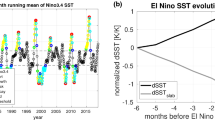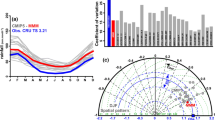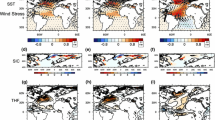Abstract
In a recent study it was illustrated that the El Nino Southern Oscillation (ENSO) mode can exist in the absence of any ocean dynamics. This oscillating mode exists just due to the interaction between atmospheric heat fluxes and ocean heat capacity. The primary purpose of this study is to further explore these atmospheric Slab Ocean ENSO dynamics and therefore the role of positive atmospheric feedbacks in model simulations and observations. The positive solar radiation feedback to sea surface temperature (SST), due to reduced cloud cover for anomalous warm SSTs, is the main positive feedback in the Slab Ocean El Nino dynamics. The strength of this positive cloud feedback is strongly related to the strength of the equatorial cold tongue. The combination of positive latent and sensible heat fluxes to the west and negative ones to the east of positive anomalies leads to the westward propagation of the SST anomalies, which allows for oscillating behavior with a preferred period of 6–7 years. Several indications are found that parts of these dynamics are indeed observed and simulated in other atmospheric or coupled general circulation models (AGCMs or CGCMs). The CMIP3 AGCM-slab ensemble of 13 different AGCM simulations shows unstable ocean–atmosphere interactions along the equatorial Pacific related to stronger cold tongues. In observations and in the CMIP3 and CMIP5 CGCM model ensemble the strength and sign of the cloud feedback is a function of the strength of the cold tongue. In summary, this indicates that the Slab Ocean El Nino dynamics are indeed a characteristic of the equatorial Pacific climate that is only dominant or significantly contributing to the ENSO dynamics if the SST cold tongue is sufficiently strong. In the observations this is only the case during strong La Nina conditions. The presence of the Slab Ocean ENSO atmospheric feedbacks in observations and CGCM model simulations implies that the family of physical ENSO modes does have another member, which is entirely driven by atmospheric processes and does not need to have the same spatial pattern nor the same time scales as the main ENSO dynamics.













Similar content being viewed by others
References
Bayr T, Dommenget D (2013) Comparing the spatial structure of variability in two datasets against each other on the basis of EOF modes. Clim Dyn (in press)
Bellenger H, Guilyardi E, Leloup J, Lengaigne M, Vialard J (2013) ENSO representation in climate models: from CMIP3 to CMIP5. Clim Dyn (in press)
Bony S, Dufresne JL (2005) Marine boundary layer clouds at the heart of tropical cloud feedback uncertainties in climate models. Geophys Res Lett 32:L20806
Burgers G, Jin FF, van Oldenborgh GJ (2005) The simplest ENSO recharge oscillator. Geophys Res Lett 32:L13706
Clement A, DiNezio P, Deser C (2011) Rethinking the Ocean’s Role in the Southern Oscillation. J Clim 24:4056–4072
Collins M, An SI, Cai WJ, Ganachaud A, Guilyardi E, Jin FF, Jochum M, Lengaigne M, Power S, Timmermann A, Vecchi G, Wittenberg A (2010) The impact of global warming on the tropical Pacific Ocean and El Nino. Nat Geosci 3:391–397
Dommenget D (2007) Evaluating EOF modes against a stochastic null hypothesis. Clim Dyn 28:517–531
Dommenget D (2010) The slab ocean El Nino. Geophys Res Lett 37:L20701
Frauen C, Dommenget D (2010) El Nino and La Nina amplitude asymmetry caused by atmospheric feedbacks. Geophys Res Lett 37:L18801
Guilyardi E, Braconnot P, Jin FF, Kim ST, Kolasinski M, Li T, Musat I (2009a) Atmosphere feedbacks during ENSO in a coupled GCM with a modified atmospheric convection scheme. J Clim 22:5698–5718
Guilyardi E, Wittenberg A, Fedorov A, Collins M, Wang CZ, Capotondi A, van Oldenborgh GJ, Stockdale T (2009b) Understanding El Nino in Ocean-Atmosphere general circulation models progress and challenges. Bull Am Meteorol Soc 90:325
Jin FF (1997) An equatorial ocean recharge paradigm for ENSO.1. Conceptual model. J Atmos Sci 54:811–829
Jin FF, Kim ST, Bejarano L (2006) A coupled-stability index for ENSO. Geophys Res Lett 33:L23708
Kalnay E, Kanamitsu M, Kistler R, Collins W, Deaven D, Gandin L, Iredell M, Saha S, White G, Woollen J, Zhu Y, Chelliah M, Ebisuzaki W, Higgins W, Janowiak J, Mo KC, Ropelewski C, Wang J, Leetmaa A, Reynolds R, Jenne R, Joseph D (1996) The NCEP/NCAR 40-year reanalysis project. Bull Am Meteorol Soc 77:437–471
Lloyd J, Guilyardi E, Weller H, Slingo J (2009) The role of atmosphere feedbacks during ENSO in the CMIP3 models. Atmos Sci Lett 10:170–176
Meehl GA, Covey C, Delworth T, Latif M, McAvaney B, Mitchell JFB, Stouffer RJ, Taylor KE (2007) The WCRP CMIP3 multimodel dataset—a new era in climate change research. Bull Am Meteorol Soc 88:1383
Neelin JD, Battisti DS, Hirst AC, Jin FF, Wakata Y, Yamagata T, Zebiak SE (1998) ENSO theory. J Geophys Res Oceans 103:14261–14290
Rayner NA, Parker DE, Horton EB, Folland CK, Alexander LV, Rowell DP, Kent EC, Kaplan A (2003) Global analyses of sea surface temperature, sea ice, and night marine air temperature since the late nineteenth century. J Geophys Res Atmos 108(D14):4407. doi:10.1029/2002JD002670
Roeckner E, Bäuml G, Bonaventura L, Brokopf R, Esch M, Giorgetta M, Hagemann S, Kirchner I, Kornblueh L, Manzini E, Rhodin A, S. U., Schulzweida U, Tompkins A (2003) The atmospheric general circulation model ECHAM 5. Part I: model description. Rep Max Planck Inst Meteorol 349
Rossow WB, Schiffer RA (1999) Advances in understanding clouds from ISCCP. Bull Am Meteorol Soc 80:2261–2287
Smith NR (1995) An improved system for tropical ocean subsurface temperature Analyses. J Atmos Ocean Technol 12:850–870
Sun DZ, Zhang T, Covey C, Klein SA, Collins WD, Hack JJ, Kiehl JT, Meehl GA, Held IM, Suarez M (2006) Radiative and dynamical feedbacks over the equatorial cold tongue: results from nine atmospheric GCMs. J Clim 19:4059–4074
Taylor KE, Stouffer RJ, Meehl GA (2012) An overview of Cmip5 and the experiment design. Bull Am Meteorol Soc 93:485–498
Webb MJ, Senior CA, Sexton DMH, Ingram WJ, Williams KD, Ringer MA, McAvaney BJ, Colman R, Soden BJ, Gudgel R, Knutson T, Emori S, Ogura T, Tsushima Y, Andronova N, Li B, Musat I, Bony S, Taylor KE (2006) On the contribution of local feedback mechanisms to the range of climate sensitivity in two GCM ensembles. Clim Dyn 27:17–38
Williams KD, Webb MJ (2009) A quantitative performance assessment of cloud regimes in climate models. Clim Dyn 33:141–157
Yu L, Jin X, Weller RA (2008) Multidecade global flux datasets from the objectively analyzed air-sea fluxes (OAFlux) project: latent and sensible heat fluxes, ocean evaporation, and related surface meteorological variables. Woods Hole Oceanographic Institution OAFlux Project Technical Report, OA-2008-01, 64
Acknowledgments
We like to thank Gerrit Burgers, Eric Guilyardi and an anonymous referee for their constructive comments, which helped to improve this article substantially. This work was supported by the ARC Centre of Excellence for Climate System Science (Grant CE110001028), the ARC project “Beyond the linear dynamics of the El Nino Southern Oscillation” (DP120101442) and the Deutsche Forschungsgemeinschaft (DFG) through project DO1038/5-1.
Author information
Authors and Affiliations
Corresponding author
Rights and permissions
About this article
Cite this article
Dommenget, D., Haase, S., Bayr, T. et al. Analysis of the Slab Ocean El Nino atmospheric feedbacks in observed and simulated ENSO dynamics. Clim Dyn 42, 3187–3205 (2014). https://doi.org/10.1007/s00382-014-2057-0
Received:
Accepted:
Published:
Issue Date:
DOI: https://doi.org/10.1007/s00382-014-2057-0




